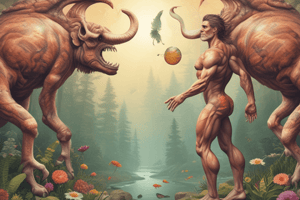Podcast
Questions and Answers
What is the primary outcome of natural selection over time?
What is the primary outcome of natural selection over time?
- Changes in the environment
- Uniformity of traits within a population
- Increased competition among organisms
- Alterations in the genetic makeup of populations (correct)
Which factor is NOT a driving force of natural selection?
Which factor is NOT a driving force of natural selection?
- Genetic drift (correct)
- Environmental pressures
- Sexual attraction
- Mating rituals
How do mutations contribute to the process of natural selection?
How do mutations contribute to the process of natural selection?
- They eliminate the need for survival competition.
- They create variations within a population. (correct)
- They always lead to beneficial traits.
- They ensure that all traits are inherited equally.
What does stabilizing selection favor within a population?
What does stabilizing selection favor within a population?
What can lead to differential survival and reproduction among individuals?
What can lead to differential survival and reproduction among individuals?
Which statement best describes sexual selection?
Which statement best describes sexual selection?
What role do predators play in natural selection?
What role do predators play in natural selection?
Which mechanism can cause random changes in allele frequencies in a population?
Which mechanism can cause random changes in allele frequencies in a population?
Flashcards
Natural Selection
Natural Selection
The process where organisms better adapted to their environment survive and reproduce more, leading to changes in the genetic makeup of a population over time.
Variation
Variation
Differences in traits within individuals of a species. These variations can be in physical characteristics, behavior, or how their body functions.
Inheritance of traits
Inheritance of traits
The passing of traits from parents to offspring. It ensures variations exist within the next generation.
Overproduction of offspring
Overproduction of offspring
Signup and view all the flashcards
Differential survival and reproduction
Differential survival and reproduction
Signup and view all the flashcards
Environmental pressures
Environmental pressures
Signup and view all the flashcards
Competition for resources
Competition for resources
Signup and view all the flashcards
Predation
Predation
Signup and view all the flashcards
Study Notes
Key Concepts of Natural Selection
- Natural selection is the process where organisms better adapted to their environment tend to survive and produce more offspring. This leads to changes in the genetic makeup of a population over time.
- Variation exists within populations. Individuals within a species exhibit variations in traits. These variations can be physical, behavioral, or physiological.
- Inheritance of traits. Variations are often heritable, meaning they can be passed down from parents to offspring.
- Overproduction of offspring. Organisms typically produce more offspring than can possibly survive. This leads to competition for limited resources.
- Differential survival and reproduction. Individuals with traits better suited to their environment are more likely to survive and reproduce, passing those advantageous traits to their offspring.
Driving Forces of Natural Selection
- Environmental pressures. The environment plays a crucial role in shaping the traits that are advantageous. Features like climate, food availability, and predators influence which traits are favoured.
- Competition for resources. Scarcity of resources like food, water, or mates forces individuals to compete for survival. Individuals with traits that allow them to compete more effectively are more likely to survive.
- Predation. Predators select against individuals that are vulnerable and less agile. Over time, populations evolve traits that make them better at avoiding predators.
Mechanisms of Natural Selection
- Mutations. Random changes in DNA sequences can create new variations within a population. These mutations can be beneficial, neutral, or detrimental, influencing how well an organism is adapted to its environment.
- Sexual selection. Individuals with traits that make them more attractive to mates are more likely to reproduce. This can drive the evolution of traits that seem less useful for survival, but are preferred by the opposite sex.
- Genetic drift. Random fluctuations in the frequencies of alleles (different versions of a gene) can occur within a population, especially in small populations. These fluctuations can lead to changes unrelated to natural selection's influence on fitness.
Patterns of Natural Selection
- Stabilizing selection: This type of selection favors the average phenotype, which can result in reduced variation within a population.
- Directional selection: Favors one extreme phenotype over the others. The population shifts its average phenotype over time.
- Disruptive selection: This type of selection favors both extreme phenotypes and reduces the frequency of the intermediate phenotype.
Studying That Suits You
Use AI to generate personalized quizzes and flashcards to suit your learning preferences.




